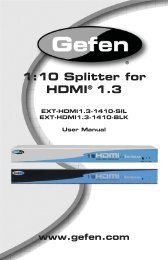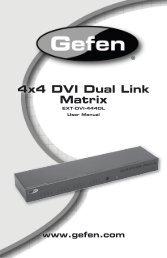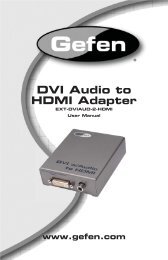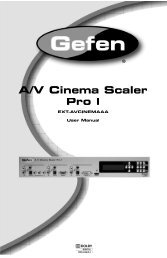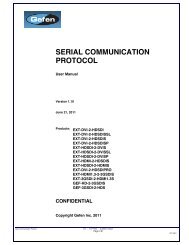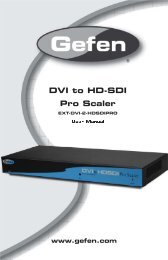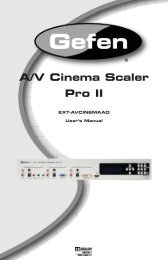Manual - Gefen
Manual - Gefen
Manual - Gefen
Create successful ePaper yourself
Turn your PDF publications into a flip-book with our unique Google optimized e-Paper software.
Advanced Operation<br />
RS-232 / IP Commands<br />
Notes:<br />
If param1 = default or param1 = dynamic, then set param2 = 0.<br />
Using Dynamic EDID<br />
When param1 = dynamic, the specified input will be set to Dynamic EDID. This can be<br />
observed by accessing the Manage EDID tab, in the Web interface. When an input is set<br />
to Dynamic EDID, the input will use the EDID of the last selected output during the routing<br />
process. The order in which outputs are routed are important when using Dynamic EDID.<br />
See the example below.<br />
Examples:<br />
#set_edid dynamic 0 input 4<br />
COPY DYNAMIC EDID TO INPUT4.<br />
In the example above, Input 4 is set to Dynamic EDID. If the following routing command is<br />
issued, then the EDID from Output C will be used (not Output B) by Input 1.<br />
r 4 b c<br />
INPUT 4 IS SET TO OUTPUTS B, C<br />
However, if we wanted to use the EDID from Output B, we would write the command as:<br />
r 4 c b<br />
INPUT 4 IS SET TO OUTPUTS C, B<br />
Since Output B was the last output that was specified, this will be the EDID that Input 4 will<br />
use.<br />
This second example does not use Dynamic EDID but uses the EDID from the specified<br />
downstream sink (display, etc):<br />
#set_edid output 1 input 3<br />
COPY OUTPUT1 EDID TO INPUT3.<br />
page | 72



